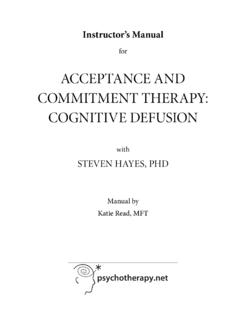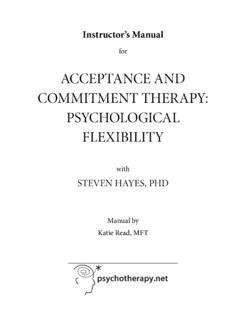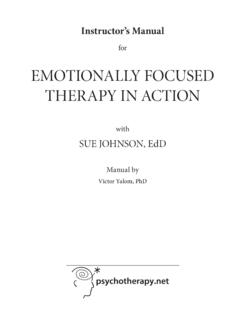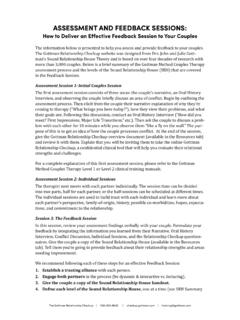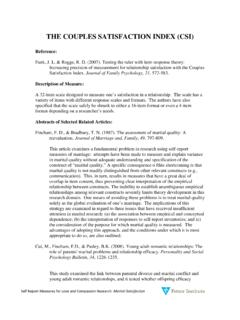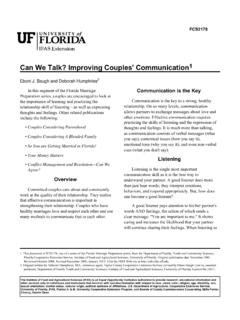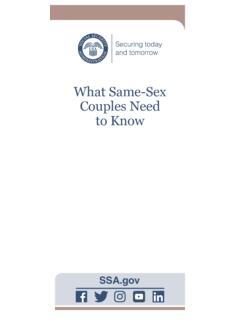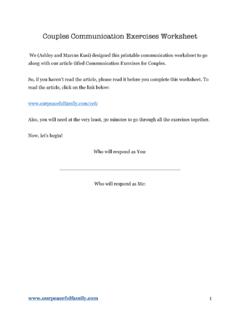Transcription of for EMOTIONALLY FOCUSED COUPLES THERAPY
1 Instructor s ManualforEMOTIONALLY FOCUSED COUPLES THERAPY withSUE JOHNSON, EDDfrom the seriesCOUPLES THERAPY WITH THE EXPERTS with hostsJon Carlson, PsyD, EdD & Diane Kjos, PhDmanual byErika L. Seid, MA and Sue Johnson, EdD2 EMOTIONALLY FOCUSED COUPLES THERAPY WITH SUE JOHnSOn, EDDThe Instructor s Manual accompanies the DVD EMOTIONALLY FOCUSED COUPLES THERAPY with Sue Johnson, PhD (Institutional/Instructor s Version). Video available at 2009, , LLC. All rights by Valley, CA Email: Phone: (800) 577-4762 (US & Canada) / (415)332-3232 Teaching and Training: Instructors, training directors and facilitators using the Instructor s Manual for the DVD EMOTIONALLY FOCUSED COUPLES THERAPY with Sue Johnson, PhD may reproduce parts of this manual in paper form for teaching and training purposes only.
2 Otherwise, the text of this publication may not be reproduced, stored in a retrieval system or transmitted in any form or by any means, electronic, mechanical, photocopying, recording or otherwise without the prior written permission of the publisher, The DVD EMOTIONALLY FOCUSED COUPLES THERAPY with Sue Johnson, PhD (Institutional/Instructor s Version) is licensed for group training and teaching purposes. Broadcasting or transmission of this video via satellite, Internet, video conferencing, streaming, distance learning courses or other means is prohibited without the prior written permission of the , Erika L., MA & Johnson, Sue, EdDInstructor s Manual for EMOTIONALLY FOCUSED COUPLES THERAPY with Sue Johnson, EdDCover design by Julie GilesOrder Information and Continuing Education Credits.
3 For information on ordering and obtaining continuing education credits for this and other psychotherapy training videos, please visit us at or call s Manual forEMOTIONALLY FOCUSED COUPLES THERAPY wITH SUE JOHNSON, EDDT able of ContentsTips for Making the Best Use of the DVD 5 Johnson s Approach to EMOTIONALLY FOCUSED COUPLES THERAPY 9 Johnson s Reflections on the Session 11 Reaction Paper for Classrooms and Training 15 Related Websites, Videos, and further Readings 17 Discussion Questions 19 Session Transcript 21 Johnson s ApproAch 21couples THERAPY session 30 Video Credits 65 Earn Continuing Education Credits for Watching Videos 67 About the Contributors 68 More Videos 704 EMOTIONALLY FOCUSED COUPLES THERAPY WITH SUE JOHnSOn, for Making the Best Use of the DVD1.
4 USE THE TRAnSCRIPTSMake notes in the video Transcript for future reference; the next time you show the video you will have them available. Highlight or notate key moments in the video to better facilitate discussion during the video and fACILITATE DISCUSSIOnPause the video at different points to elicit viewers observations and reactions to the concepts presented. The Discussion Questions provide ideas about key points that can stimulate rich discussions and LET IT fLOWI nstead of stopping the video often, allow the session to play out so viewers can appreciate the flow of the session. It is best to watch the video in its entirety since issues untouched in earlier parts often play out later. Encourage viewers to voice their opinions; no THERAPY is perfect!
5 What are viewers impressions of what works and does not work in the session? We learn as much from our mistakes as our successes; it is crucial for students and therapists to develop the ability to effectively critique this work as well as their SUGGEST READInGS TO EnRICH VIDEO MATERIALA ssign readings from Suggestions for Further Readings and Websites prior to viewing.. You can also schedule the video to coincide with other course or training materials on related REfLECT On REfLECTIOnSHand out copies of Johnson s Reflections on the Session, giving participants an inside view of Johnson s experience of her work with this couple. Johnson s reflections humanize the process and provide viewers a context into which they can place the person of the therapist.
6 In this way, Johnson becomes not just an expert therapist but also a real FOCUSED COUPLES THERAPY WITH SUE JOHnSOn, EDD6. ASSIGn A REACTIOn PAPERSee suggestions in Reaction Paper COnDUCT ROLE-PLAYSA fter watching the video, assign groups to role-play a COUPLES THERAPY session following Johnson s EMOTIONALLY FOCUSED COUPLES THERAPY model. Organize participants into triads, consisting of one psychotherapist and one client couple. Then rotate so each person has a chance to play the role of therapist. As a basic instruction, suggest to therapists that they focus on helping clients identify and explore the emotions that underlie the presenting problem. The therapist can help each client verbalize emotions to their partner, and encourage the partner to hear and take in the other s vulnerable expression.
7 Have therapists closely track the couple s experience and patterns of interactions as they occur in the session, and reflect their observation of these patterns to the couple. See Johnson s Approach to EMOTIONALLY FOCUSED COUPLES THERAPY in this manual for a brief review of how Johnson each role-play, debrief the groups. First have the clients share their experiences; have them discuss what they learned about the clients experience in this exercise. Then have the therapists talk about what the session was like for them. What did participants find challenging or exciting about this way of working? If they had the opportunity to continue working with this couple, what would be their goal in terms of changing the patterns or cycles of interactions? Based on this brief role-play, did the therapist have any understanding or hypotheses about the clients cycle of interactions from an attachment theory perspective?
8 Finally, have the large group reconvene to share their reactions, and open up a general discussion on what participants learned about Johnson s approach to EMOTIONALLY FOCUSED COUPLES alternative is to do this role-play in front of the whole group with one therapist and one client couple; the entire group can observe, acting as the advising team to the therapist. Before the end of the session, have the therapist take a break, get feedback from the team, and bring it back into the session with the client. Other observers might jump in if the therapist gets stuck. Follow up with a discussion of what does and does not seem effective about Johnson s WATCH THE EXPERTS SERIESThis video is one in a series portraying leading theories of psychotherapy and their application in work with COUPLES .
9 Each video in the series presents a master COUPLES therapist working with a real couple who has real problems. By showing several of the videos in this COUPLES THERAPY with the Experts series (See the More Videos section for a complete list), you can expose viewers to a variety of styles and approaches, allowing them an opportunity to see what fits best for them. Other videos in the series use different therapeutic models to explain how COUPLES interact and how change occurs within the couple. We can reflect upon the differences among these models by exploring how each one approaches the main objectives of COUPLES THERAPY : removing, decreasing or modifying symptoms or problems in the relationship mediating negative patterns of behavior promoting positive growth and development within the family systemPERSPECTIVE On VIDEOS AnD THE PERSOnALITY Of THE THERAPISTP sychotherapy portrayed in videos is less off-the-cuff than THERAPY in practice.
10 Therapists may feel put on the spot to offer a good demonstration, and clients can be self-conscious in front of a camera. Therapists often move more quickly than they would in everyday practice to demonstrate a particular technique. Despite these factors, therapists and clients on video can engage in a realistic session that conveys a wealth of information not contained in books or THERAPY transcripts: body language, tone of voice, facial expression, rhythm of the interaction, quality of the alliance all aspects of the therapeutic 8 EMOTIONALLY FOCUSED COUPLES THERAPY WITH SUE JOHnSOn, EDDrelationship that are unique to an interpersonal encounter. Psychotherapy is an intensely private matter. Unlike the training in other professions, students and practitioners rarely have an opportunity to see their mentors at work.

